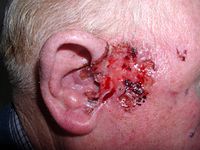
Photo from wikipedia
BACKGROUND Laparoscopic hepatectomy for centrally located hepatocellular carcinoma is challenging to perform. Augmented reality navigation (ARN) and fluorescence imaging are currently safe and reproducible techniques for hepatectomy, but the efficacy… Click to show full abstract
BACKGROUND Laparoscopic hepatectomy for centrally located hepatocellular carcinoma is challenging to perform. Augmented reality navigation (ARN) and fluorescence imaging are currently safe and reproducible techniques for hepatectomy, but the efficacy results for centrally located hepatocellular carcinoma have not been reported. This study aimed to evaluate the efficacy of an ARN system combined with fluorescence imaging (ARN-FI) in laparoscopic hepatectomy for centrally located hepatocellular carcinoma. STUDY DESIGN This was a post hoc analysis of an original nonrandomized clinical trial that was designed to evaluate the feasibility and efficacy of ARN-FI for laparoscopic liver resection. A total of 76 patients were consecutively enrolled from June 2018 to June 2021, of which 42 underwent laparoscopic hepatectomy using ARN-FI (ARN-FI group), and the other 34 who did not use ARN-FI guidance (non-ARN-FI group). Perioperative outcomes and disease-free survival were compared between the 2 groups. RESULTS Compared with the non-ARN-FI group, the ARN-FI group had less intraoperative blood loss (median 275 vs 300 mL, p = 0.013), lower intraoperative transfusion rate (14.3% vs 64.7%, p < 0.01), shorter postoperative hospital stay (median 8 vs 9 days, p = 0.005), and lower postoperative complication rate (35.7% vs 61.8%, p = 0.024). There was no death in the perioperative period and follow-up period. There was no significant difference in overall disease-free survival between the 2 groups (p = 0.16). CONCLUSIONS The ARN system and fluorescence imaging may be of value in improving the success rate of surgery, reducing postoperative complications, accelerating postoperative recovery, and shortening postoperative hospital stay.
Journal Title: Journal of the American College of Surgeons
Year Published: 2022
Link to full text (if available)
Share on Social Media: Sign Up to like & get
recommendations!